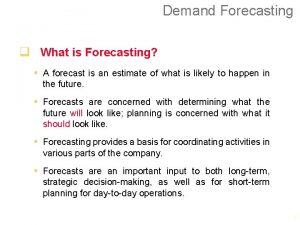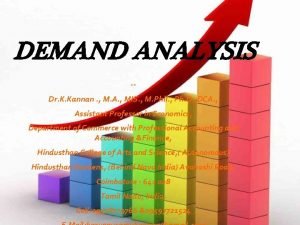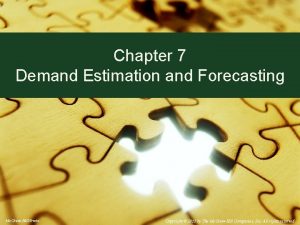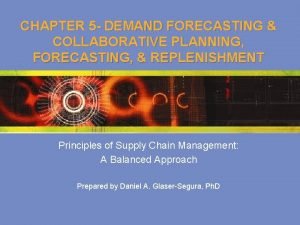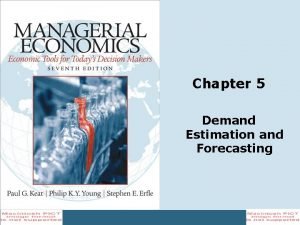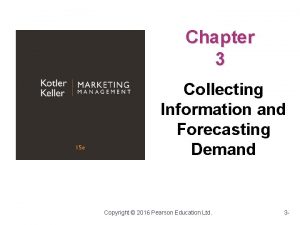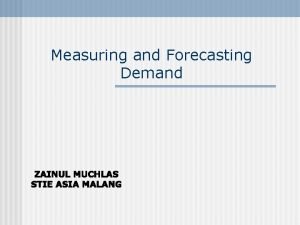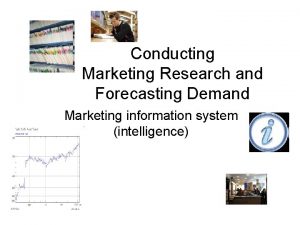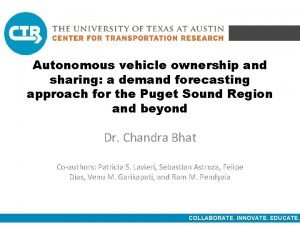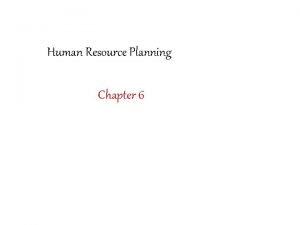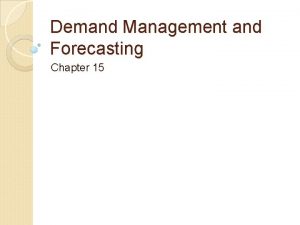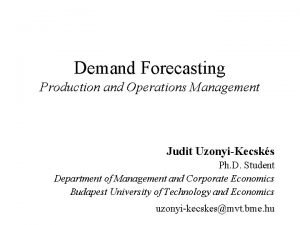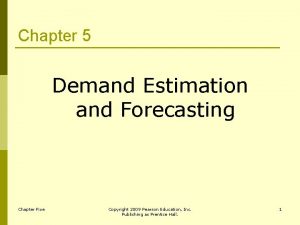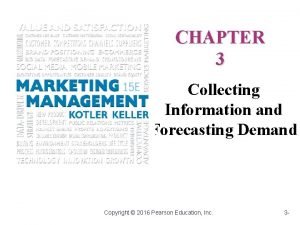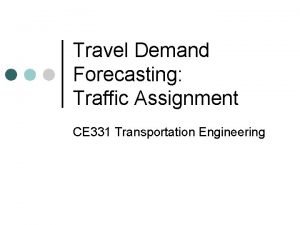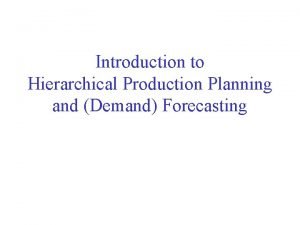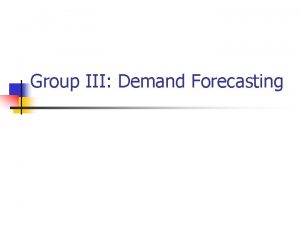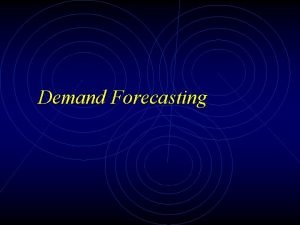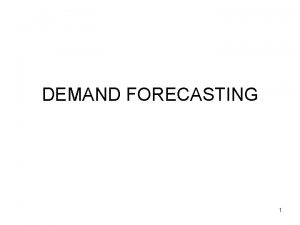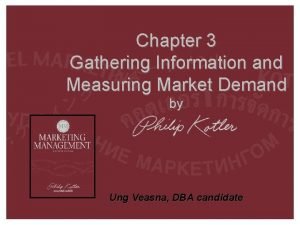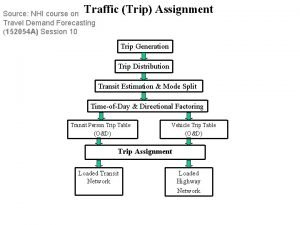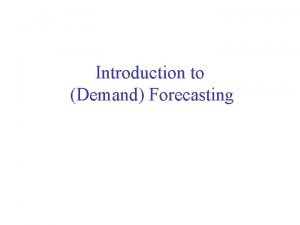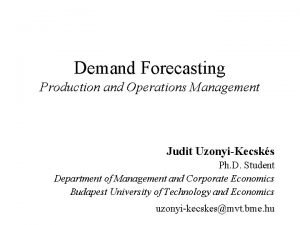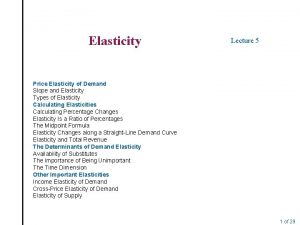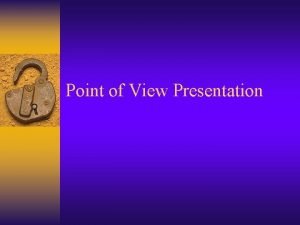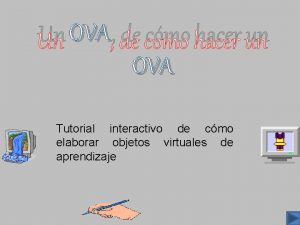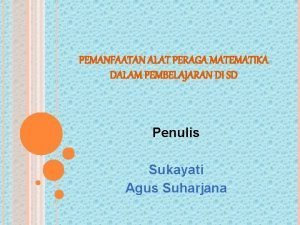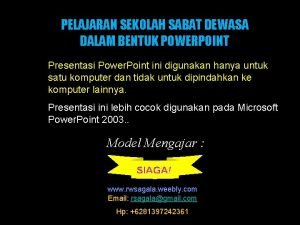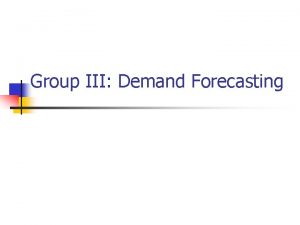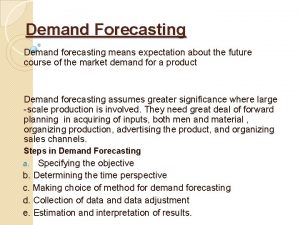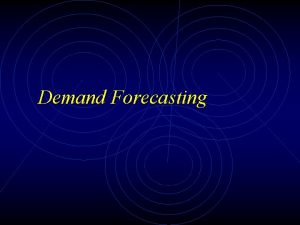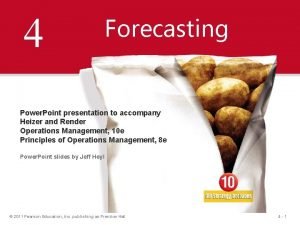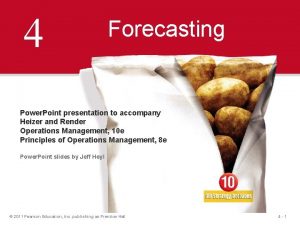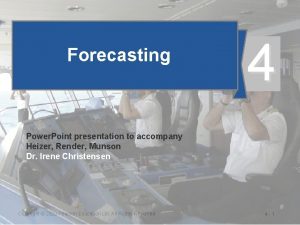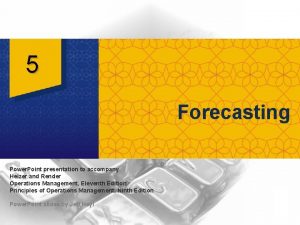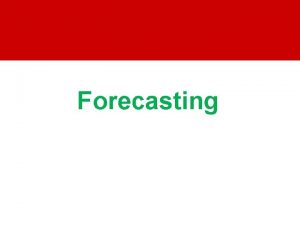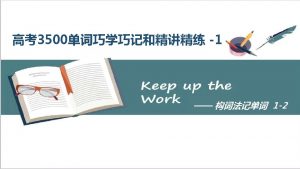4 Forecasting Demand Power Point presentation to accompany


































































![Correlation Coefficient r= n. Sxy - Sx. Sy [n. Sx 2 - (Sx)2][n. Sy Correlation Coefficient r= n. Sxy - Sx. Sy [n. Sx 2 - (Sx)2][n. Sy](https://slidetodoc.com/presentation_image_h2/73b1514edfb0197dbd314704931f86fa/image-67.jpg)
![Correlation Coefficient y y n. Sxy - Sx. Sy r= 2 - (Sx)2][n. Sy Correlation Coefficient y y n. Sxy - Sx. Sy r= 2 - (Sx)2][n. Sy](https://slidetodoc.com/presentation_image_h2/73b1514edfb0197dbd314704931f86fa/image-68.jpg)







- Slides: 75

4 Forecasting Demand Power. Point presentation to accompany Heizer and Render Operations Management, 10 e, Global Edition Principles of Operations Management, 8 e, Global Edition Power. Point slides by Jeff Heyl © 2011 Pearson Education 4 -1

What is Forecasting? u Process of predicting a future event u Underlying basis of all business decisions ? ? u Production u Inventory u Personnel u Facilities © 2011 Pearson Education 4 -2

Forecasting Time Horizons u Short-range forecast u Up to 1 year, generally less than 3 months u Purchasing, job scheduling, workforce levels, job assignments, production levels u Medium-range forecast u 3 months to 3 years u Sales and production planning, budgeting u Long-range forecast u 3+ years u New product planning, facility location, research and development © 2011 Pearson Education 4 -3

Distinguishing Differences u Medium/long range forecasts deal with more comprehensive issues and support management decisions regarding planning and products, plants and processes u Short-term forecasting usually employs different methodologies than longer-term forecasting u Short-term forecasts tend to be more accurate than longer-term forecasts © 2011 Pearson Education 4 -4

Influence of Product Life Cycle Introduction – Growth – Maturity – Decline u Introduction and growth require longer forecasts than maturity and decline u As product passes through life cycle, forecasts are useful in projecting u Staffing levels u Inventory levels u Factory capacity © 2011 Pearson Education 4 -5

Product Life Cycle Company Strategy/Issues Introduction Growth Maturity Decline Best period to increase market share Practical to change price or quality image Poor time to change image, price, or quality R&D engineering is critical Strengthen niche Competitive costs become critical Defend market position Drive-through Internet search engines i. Pods Xbox 360 Sales Cost control critical restaurants CD-ROMs LCD & plasma TVs Avatars Boeing 787 Twitter Analog TVs Figure 2. 5 © 2011 Pearson Education 4 -6

Product Life Cycle OM Strategy/Issues Introduction Product design and development critical Frequent product and process design changes Short production runs High production costs Limited models Attention to quality Growth Forecasting critical Maturity Standardization Fewer product Product and changes, more process minor changes reliability Optimum Competitive capacity product Increasing improvements stability of and options process Increase capacity Long production runs Shift toward product focus Product improvement and Enhance cost cutting distribution Decline Little product differentiation Cost minimization Overcapacity in the industry Prune line to eliminate items not returning good margin Reduce capacity Figure 2. 5 © 2011 Pearson Education 4 -7

Types of Forecasts u Economic forecasts u Address business cycle – inflation rate, money supply, housing starts, etc. u Technological forecasts u Predict rate of technological progress u Impacts development of new products u Demand forecasts u Predict sales of existing products and services © 2011 Pearson Education 4 -8

Strategic Importance of Forecasting u Human Resources – Hiring, training, laying off workers u Capacity – Capacity shortages can result in undependable delivery, loss of customers, loss of market share u Supply Chain Management – Good supplier relations and price advantages © 2011 Pearson Education 4 -9

Seven Steps in Forecasting 1. Determine the use of the forecast 2. Select the items to be forecasted 3. Determine the time horizon of the forecast 4. Select the forecasting model(s) 5. Gather the data 6. Make the forecast 7. Validate and implement results © 2011 Pearson Education 4 - 10

The Realities! u Forecasts are seldom perfect u Most techniques assume an underlying stability in the system © 2011 Pearson Education 4 - 11

Forecasting Approaches Qualitative Methods u Used when situation is vague and little data exist u New products u New technology u Involves intuition, experience u e. g. , forecasting sales on Internet © 2011 Pearson Education 4 - 12

Forecasting Approaches Quantitative Methods u Used when situation is ‘stable’ and historical data exist u Existing products u Current technology u Involves mathematical techniques u e. g. , forecasting sales of color televisions © 2011 Pearson Education 4 - 13

Overview of Qualitative Methods 1. Jury of executive opinion u Pool opinions of high-level experts, sometimes augment by statistical models 2. Delphi method u Panel of experts, queried iteratively © 2011 Pearson Education 4 - 14

Overview of Qualitative Methods 3. Sales force composite u Estimates from individual salespersons are reviewed for reasonableness, then aggregated 4. Consumer Market Survey u Ask the customer © 2011 Pearson Education 4 - 15

Jury of Executive Opinion u Involves small group of high-level experts and managers u Group estimates demand by working together u Combines managerial experience with statistical models u Relatively quick u ‘Group-think’ disadvantage © 2011 Pearson Education 4 - 16

Sales Force Composite u Each salesperson projects his or her sales u Combined at district and national levels u Sales reps know customers’ wants u Tends to be overly optimistic © 2011 Pearson Education 4 - 17

Delphi Method u Iterative group process, continues until consensus is reached u 3 types of participants Decision Makers (Evaluate responses and make decisions) Staff (Administering survey) u Decision makers u Staff u Respondents © 2011 Pearson Education Respondents (People who can make valuable judgments) 4 - 18

Consumer Market Survey u Ask customers about purchasing plans u What consumers say, and what they actually do are often different u Sometimes difficult to answer © 2011 Pearson Education 4 - 19

Overview of Quantitative Approaches 1. Naive approach 2. Moving averages 3. Exponential smoothing time-series models 4. Trend projection 5. Linear regression © 2011 Pearson Education associative model 4 - 20

Time Series Forecasting u Set of evenly spaced numerical data u Obtained by observing response variable at regular time periods u Forecast based only on past values, no other variables important u Assumes that factors influencing past and present will continue influence in future © 2011 Pearson Education 4 - 21

Time Series Components Trend Cyclical Seasonal Random © 2011 Pearson Education 4 - 22

Components of Demand for product or service Trend component Seasonal peaks Actual demand line Average demand over 4 years Random variation | 1 | 2 | 3 Time (years) © 2011 Pearson Education | 4 Figure 4. 1 4 - 23

Trend Component u Persistent, overall upward or downward pattern u Changes due to population, technology, age, culture, etc. u Typically several years duration © 2011 Pearson Education 4 - 24

Seasonal Component u Regular pattern of up and down fluctuations u Due to weather, customs, etc. u Occurs within a single year © 2011 Pearson Education Period Length Number of Seasons Week Month Year Day Week Day Quarter Month Week 7 4 -4. 5 28 -31 4 12 52 4 - 25

Cyclical Component u Repeating up and down movements u Affected by business cycle, political, and economic factors u Multiple years duration u Often causal or associative relationships 0 © 2011 Pearson Education 5 10 15 20 4 - 26

Random Component u Erratic, unsystematic, ‘residual’ fluctuations u Due to random variation or unforeseen events u Short duration and nonrepeating © 2011 Pearson Education M T W T F 4 - 27

Naive Approach u Assumes demand in next period is the same as demand in most recent period u e. g. , If January sales were 68, then February sales will be 68 u Sometimes cost effective and efficient u Can be good starting point © 2011 Pearson Education 4 - 28

Moving Average Method u MA is a series of arithmetic means u Used if little or no trend u Used often for smoothing u Provides overall impression of data over time ∑ demand in previous n periods Moving average = n © 2011 Pearson Education 4 - 29

Moving Average Example Month Actual Shed Sales 3 -Month Moving Average January February March April May June July 10 12 13 16 19 23 26 (10 + 12 + 13)/3 13 = 11 2/3 (12 + 13 + 16)/3 = 13 2/3 (13 + 16 + 19)/3 = 16 (16 + 19 + 23)/3 = 19 1/3 © 2011 Pearson Education 4 - 30

Shed Sales Graph of Moving Average 30 28 26 24 22 20 18 16 14 12 10 – – – © 2011 Pearson Education Moving Average Forecast Actual Sales | | | J F M A M J J A S O N D 4 - 31

Weighted Moving Average u Used when some trend might be present u Older data usually less important u Weights based on experience and intuition Weighted moving average = © 2011 Pearson Education ∑ (weight for period n) x (demand in period n) ∑ weights 4 - 32

Weights Applied 3 2 1 6 Period Last month Two months ago Three months ago Sum of weights Weighted Moving Average Month Actual Shed Sales January February March April May June July 10 12 13 16 19 23 26 © 2011 Pearson Education 3 -Month Weighted Moving Average [(3 x 13) = 121/6 13 + (2 x 12) 12 + (10)]/6 10 [(3 x 16) + (2 x 13) + (12)]/6 = 141/3 [(3 x 19) + (2 x 16) + (13)]/6 = 17 [(3 x 23) + (2 x 19) + (16)]/6 = 201/2 4 - 33

Potential Problem With Moving Average u Require extensive historical data © 2011 Pearson Education 4 - 34

Moving Average And Weighted Moving Average Weighted moving average Sales demand 30 – 25 – Actual sales 20 – 15 – Moving average 10 – 5 – | Figure 4. 2 J © 2011 Pearson Education | F | M | A | M | J | A | S | O | N | D 4 - 35

Exponential Smoothing u Form of weighted moving average u Weights decline exponentially u Most recent data weighted most u Requires smoothing constant ( ) u Ranges from 0 to 1 u Subjectively chosen u Involves little record keeping of past data © 2011 Pearson Education 4 - 36

Exponential Smoothing New forecast = Last period’s forecast + (Last period’s actual demand – Last period’s forecast) Ft = Ft – 1 + (At – 1 - Ft – 1) where Ft = new forecast Ft – 1 = previous forecast = smoothing (or weighting) constant (0 ≤ ≤ 1) © 2011 Pearson Education 4 - 37

Exponential Smoothing Example Predicted demand = 142 Ford Mustangs Actual demand = 153 Smoothing constant =. 20 © 2011 Pearson Education 4 - 38

Exponential Smoothing Example Predicted demand = 142 Ford Mustangs Actual demand = 153 Smoothing constant =. 20 New forecast = 142 +. 2(153 – 142) © 2011 Pearson Education 4 - 39

Exponential Smoothing Example Predicted demand = 142 Ford Mustangs Actual demand = 153 Smoothing constant =. 20 New forecast = 142 +. 2(153 – 142) = 142 + 2. 2 = 144. 2 ≈ 144 cars © 2011 Pearson Education 4 - 40

Choosing The objective is to obtain the most accurate forecast no matter the technique We generally do this by selecting the model that gives us the lowest forecast error Forecast error = Actual demand - Forecast value = At - F t © 2011 Pearson Education 4 - 41

Common Measures of Error Mean Absolute Deviation (MAD) MAD = ∑ |Actual - Forecast| n Mean Squared Error (MSE) MSE = © 2011 Pearson Education ∑ (Forecast Errors)2 n 4 - 42

Common Measures of Error Mean Absolute Percent Error (MAPE) n MAPE = © 2011 Pearson Education ∑ 100|Actuali - Forecasti|/Actuali i=1 n 4 - 43

Comparison of Forecast Error Quarter Actual Tonnage Unloaded Rounded Forecast with =. 10 Absolute Deviation for =. 10 1 2 3 4 5 6 7 8 180 168 159 175 190 205 180 182 175. 5 174. 75 173. 18 173. 36 175. 02 178. 22 5. 00 7. 50 15. 75 1. 82 16. 64 29. 98 1. 98 3. 78 82. 45 © 2011 Pearson Education Rounded Forecast with =. 50 175 177. 50 172. 75 165. 88 170. 44 180. 22 192. 61 186. 30 Absolute Deviation for =. 50 5. 00 9. 50 13. 75 9. 12 19. 56 24. 78 12. 61 4. 30 98. 62 4 - 44

Comparison of Forecast Error ∑ |deviations| Rounded Absolute MADActual = Quarter Tonnage Unloaded Forecast n with =. 10 Deviation for =. 10 For 180 =. 10 175 5. 00 168 = 82. 45/8 175. 5 = 10. 31 7. 50 1 2 3 4 For 5 6 7 8 159 174. 75 175 =. 50 173. 18 190 173. 36 205 = 98. 62/8 175. 02 180 178. 02 182 178. 22 © 2011 Pearson Education = 15. 75 1. 82 16. 64 12. 33 29. 98 1. 98 3. 78 82. 45 Rounded Forecast with =. 50 175 177. 50 172. 75 165. 88 170. 44 180. 22 192. 61 186. 30 Absolute Deviation for =. 50 5. 00 9. 50 13. 75 9. 12 19. 56 24. 78 12. 61 4. 30 98. 62 4 - 45

Comparison of Forecast Error 2 ∑ (forecast errors) Rounded Absolute MSE = Actual Quarter Tonnage Unloaded Forecast n with =. 10 Deviation for =. 10 For 180 =. 10 175 5. 00 168 175. 5 = 190. 82 7. 50 = 1, 526. 54/8 1 2 3 4 For 5 6 7 8 159 174. 75 175 =. 50 173. 18 190 173. 36 = 1, 561. 91/8 205 175. 02 180 178. 02 182 178. 22 MAD © 2011 Pearson Education = 15. 75 1. 82 16. 64 195. 24 29. 98 1. 98 3. 78 82. 45 10. 31 Rounded Forecast with =. 50 175 177. 50 172. 75 165. 88 170. 44 180. 22 192. 61 186. 30 Absolute Deviation for =. 50 5. 00 9. 50 13. 75 9. 12 19. 56 24. 78 12. 61 4. 30 98. 62 12. 33 4 - 46

Comparison of Forecast n Error ∑ 100|deviation |/actuali i Rounded Absolute Rounded i=1 MAPE = Actual Quarter 1 2 3 4 5 6 7 8 Tonnage Unloaded Forecast with =. 10 n Deviation for =. 10 For 180 =. 10 175 5. 00 168 175. 5 = 44. 75/8 = 7. 50 5. 59% 159 For 175 = 190 205 180 182 © 2011 Pearson Education 174. 75 15. 75 1. 82. 50 173. 18 173. 36 16. 64 = 54. 05/8 =29. 98 6. 76% 175. 02 178. 02 1. 98 178. 22 3. 78 82. 45 MAD 10. 31 MSE 190. 82 Forecast with =. 50 175 177. 50 172. 75 165. 88 170. 44 180. 22 192. 61 186. 30 Absolute Deviation for =. 50 5. 00 9. 50 13. 75 9. 12 19. 56 24. 78 12. 61 4. 30 98. 62 12. 33 195. 24 4 - 47

Comparison of Forecast Error Quarter Actual Tonnage Unloaded Rounded Forecast with =. 10 1 2 3 4 5 6 7 8 180 168 159 175 190 205 180 182 175. 5 174. 75 173. 18 173. 36 175. 02 178. 22 © 2011 Pearson Education MAD MSE MAPE Absolute Deviation for =. 10 5. 00 7. 50 15. 75 1. 82 16. 64 29. 98 1. 98 3. 78 82. 45 10. 31 190. 82 5. 59% Rounded Forecast with =. 50 175 177. 50 172. 75 165. 88 170. 44 180. 22 192. 61 186. 30 Absolute Deviation for =. 50 5. 00 9. 50 13. 75 9. 12 19. 56 24. 78 12. 61 4. 30 98. 62 12. 33 195. 24 6. 76% 4 - 48

Trend Projections Fitting a trend line to historical data points to project into the medium to long-range Linear trends can be found using the least squares technique y^ = a + bx where y^ = computed value of the variable to be predicted (dependent variable) a = y-axis intercept b = slope of the regression line x = the independent variable © 2011 Pearson Education 4 - 49

Least Squares Method Equations to calculate the regression variables y^ = a + bx b= Sxy - nxy Sx 2 - nx 2 a = y - bx © 2011 Pearson Education 4 - 50

Least Squares Example Year 2003 2004 2005 2006 2007 2008 2009 Time Period (x) 1 2 3 4 5 6 7 ∑x = 28 x=4 Electrical Power Demand 74 79 80 90 105 142 122 ∑y = 692 y = 98. 86 x 2 xy 1 4 9 16 25 36 49 ∑x 2 = 140 74 158 240 360 525 852 854 ∑xy = 3, 063 - (7)(4)(98. 86) ∑xy - nxy b= = = 10. 54 2 2 2 140 - (7)(4 ) ∑x - nx a = y - bx = 98. 86 - 10. 54(4) = 56. 70 © 2011 Pearson Education 4 - 51

Least Squares Example Year Time Period (x) Electrical Power Demand x 2 xy 2003 1 74 1 2004 2 79 4 line is 80 2005 The trend 3 9 2006 4 90 16 2007 105 25 y^ 5= 56. 70 + 10. 54 x 2008 6 142 36 2009 7 122 49 ∑x = 28 ∑y = 692 ∑x 2 = 140 x=4 y = 98. 86 74 158 240 360 525 852 854 ∑xy = 3, 063 - (7)(4)(98. 86) ∑xy - nxy b= = = 10. 54 2 2 2 140 - (7)(4 ) ∑x - nx a = y - bx = 98. 86 - 10. 54(4) = 56. 70 © 2011 Pearson Education 4 - 52

Power demand Least Squares Example 160 150 140 130 120 110 100 90 80 70 60 50 – – – Trend line, y^ = 56. 70 + 10. 54 x | 2003 © 2011 Pearson Education | 2004 | 2005 | 2006 | 2007 Year | 2008 | 2009 | 2010 | 2011 4 - 53

Seasonal Variations In Data The multiplicative seasonal model can adjust trend data for seasonal variations in demand © 2011 Pearson Education 4 - 55

Seasonal Variations In Data Steps in the process: 1. Find average historical demand for each season 2. Compute the average demand over all seasons 3. Compute a seasonal index for each season 4. Estimate next year’s total demand 5. Divide this estimate of total demand by the number of seasons, then multiply it by the seasonal index for that season © 2011 Pearson Education 4 - 56

Seasonal Index Example Month Jan Feb Mar Apr May Jun Jul Aug Sept Oct Nov Dec Demand 2007 2008 2009 80 70 80 90 113 110 100 88 85 77 75 82 © 2011 Pearson Education 85 85 93 95 125 115 102 90 78 72 78 105 85 82 115 131 120 113 110 95 85 83 80 Average 2007 -2009 Average Monthly 90 80 85 100 123 115 100 90 80 80 80 94 94 94 Seasonal Index 4 - 57

Seasonal Index Example Month Demand 2007 2008 2009 Average 2007 -2009 Average Monthly Jan 80 85 105 90 94 Feb 70 85 85 80 94 Mar 80 93 Average 82 85 monthly 94 2007 -2009 demand Seasonal 90 index 95= 115 Apr 100 94 Average monthly demand May 113 125 131 123 94 = 90/94 =. 957 Jun 110 115 120 115 94 Jul 100 102 113 105 94 Aug 88 102 110 100 94 Sept 85 90 94 Oct 77 78 85 80 94 Nov 75 72 83 80 94 Dec 82 78 80 80 94 © 2011 Pearson Education Seasonal Index 0. 957 4 - 58

Seasonal Index Example Month Jan Feb Mar Apr May Jun Jul Aug Sept Oct Nov Dec Demand 2007 2008 2009 80 70 80 90 113 110 100 88 85 77 75 82 © 2011 Pearson Education 85 85 93 95 125 115 102 90 78 72 78 105 85 82 115 131 120 113 110 95 85 83 80 Average 2007 -2009 Average Monthly Seasonal Index 90 80 85 100 123 115 100 90 80 80 80 94 94 94 0. 957 0. 851 0. 904 1. 064 1. 309 1. 223 1. 117 1. 064 0. 957 0. 851 4 - 59

Seasonal Index Example Month Jan Feb Mar Apr May Jun Jul Aug Sept Oct Nov Dec Demand 2007 2008 2009 Average 2007 -2009 Average Monthly 80 85 105 90 94 for 802010 70 85 Forecast 85 94 80 93 82 85 94 annual demand = 1, 200 90 Expected 95 115 100 94 113 125 131 123 94 110 115 120 1, 200 115 94 Jan 113 x. 957 = 96 94 100 102 105 12 88 102 110 100 94 1, 200 85 90 Feb 95 x 90. 851 = 85 94 77 78 85 12 80 94 75 72 83 80 94 82 78 80 80 94 © 2011 Pearson Education Seasonal Index 0. 957 0. 851 0. 904 1. 064 1. 309 1. 223 1. 117 1. 064 0. 957 0. 851 4 - 60

Seasonal Index Example 2010 Forecast 2009 Demand 2008 Demand 2007 Demand 140 – 130 – Demand 120 – 110 – 100 – 90 – 80 – 70 – © 2011 Pearson Education | J | F | M | A | M | | J J Time | A | S | O | N | D 4 - 61

Associative Forecasting Used when changes in one or more independent variables can be used to predict the changes in the dependent variable Most common technique is linear regression analysis We apply this technique just as we did in the time series example © 2011 Pearson Education 4 - 62

Associative Forecasting an outcome based on predictor variables using the least squares technique y^ = a + bx where y^ = computed value of the variable to be predicted (dependent variable) a = y-axis intercept b = slope of the regression line x = the independent variable though to predict the value of the dependent variable © 2011 Pearson Education 4 - 63

Associative Forecasting Example Area Payroll ($ billions), x 1 3 4 4. 0 – 2 1 3. 0 – 7 Sales ($ millions), y 2. 0 3. 0 2. 5 2. 0 3. 5 2. 0 – 1. 0 – 0 © 2011 Pearson Education | 1 | 2 | | 3 4 5 6 Area payroll | 7 4 - 64

Associative Forecasting Example Sales, y 2. 0 3. 0 2. 5 2. 0 3. 5 ∑y = 15. 0 Payroll, x 1 3 4 2 1 7 ∑x = 18 x = ∑x/6 = 18/6 = 3 y = ∑y/6 = 15/6 = 2. 5 © 2011 Pearson Education b= x 2 1 9 16 4 1 49 ∑x 2 = 80 ∑xy - nxy ∑x 2 - nx 2 = xy 2. 0 9. 0 10. 0 4. 0 24. 5 ∑xy = 51. 5 - (6)(3)(2. 5) 80 - (6)(32) =. 25 a = y - bx = 2. 5 - (. 25)(3) = 1. 75 4 - 65

Associative Forecasting Example If payroll next year is estimated to be $6 billion, then: Sales = 1. 75 +. 25(6) Sales = $3, 250, 000 Sales = 1. 75 +. 25(payroll) 4. 0 – Nodel’s sales y^ = 1. 75 +. 25 x 3. 25 3. 0 – 2. 0 – 1. 0 – 0 © 2011 Pearson Education | 1 | 2 | | 3 4 5 6 Area payroll | 7 4 - 66

Correlation u How strong is the linear relationship between the variables? u Correlation does not necessarily imply causality! u Coefficient of correlation, r, measures degree of association u Values range from -1 to +1 © 2011 Pearson Education 4 - 67
![Correlation Coefficient r n Sxy Sx Sy n Sx 2 Sx2n Sy Correlation Coefficient r= n. Sxy - Sx. Sy [n. Sx 2 - (Sx)2][n. Sy](https://slidetodoc.com/presentation_image_h2/73b1514edfb0197dbd314704931f86fa/image-67.jpg)
Correlation Coefficient r= n. Sxy - Sx. Sy [n. Sx 2 - (Sx)2][n. Sy 2 - (Sy)2] © 2011 Pearson Education 4 - 68
![Correlation Coefficient y y n Sxy Sx Sy r 2 Sx2n Sy Correlation Coefficient y y n. Sxy - Sx. Sy r= 2 - (Sx)2][n. Sy](https://slidetodoc.com/presentation_image_h2/73b1514edfb0197dbd314704931f86fa/image-68.jpg)
Correlation Coefficient y y n. Sxy - Sx. Sy r= 2 - (Sx)2][n. Sy 2 - (Sy)2] [n. Sx (a) Perfect positive x (b) Positive correlation: r = +1 x correlation: 0<r<1 y y (c) No correlation: r=0 © 2011 Pearson Education x (d) Perfect negative x correlation: r = -1 4 - 69

Correlation u Coefficient of Determination, r 2, measures the percent of change in y predicted by the change in x u Values range from 0 to 1 u Easy to interpret For the Nodel Construction example: r =. 901 r 2 =. 81 © 2011 Pearson Education 4 - 70

Adaptive Forecasting u It’s possible to use the computer to continually monitor forecast error and adjust the values of the and b coefficients used in exponential smoothing to continually minimize forecast error u This technique is called adaptive smoothing © 2011 Pearson Education 4 - 71

Focus Forecasting u Developed at American Hardware Supply, based on two principles: 1. Sophisticated forecasting models are not always better than simple ones 2. There is no single technique that should be used for all products or services u This approach uses historical data to test multiple forecasting models for individual items u The forecasting model with the lowest error is then used to forecast the next demand © 2011 Pearson Education 4 - 72

Forecasting in the Service Sector u Presents unusual challenges u Special need for short term records u Needs differ greatly as function of industry and product u Holidays and other calendar events u Unusual events © 2011 Pearson Education 4 - 73

Percentage of sales Fast Food Restaurant Forecast 20% – 15% – 10% – 5% – 11 -12 1 -2 12 -1 (Lunchtime) © 2011 Pearson Education 2 -3 3 -4 4 -5 5 -6 7 -8 6 -7 (Dinnertime) Hour of day 8 -9 9 -10 10 -11 Figure 4. 12 4 - 74

Fed. Ex Call Center Forecast 12% – 10% – 8% – 6% – 4% – 2% – 0% – 2 4 6 8 A. M. 10 12 2 Hour of day 4 6 8 P. M. 10 12 Figure 4. 12 © 2011 Pearson Education 4 - 75

All rights reserved. No part of this publication may be reproduced, stored in a retrieval system, or transmitted, in any form or by any means, electronic, mechanical, photocopying, recording, or otherwise, without the prior written permission of the publisher. Printed in the United States of America. © 2011 Pearson Education 4 - 76
 What is demand forecasting and estimation
What is demand forecasting and estimation Things that belong to salvation
Things that belong to salvation Accompany chapter 1
Accompany chapter 1 Brachial vein
Brachial vein Printers create objects such as prototypes and models.
Printers create objects such as prototypes and models. Hotel demand forecasting
Hotel demand forecasting Statistical methods of demand forecasting
Statistical methods of demand forecasting Chain ratio method demand forecasting examples
Chain ratio method demand forecasting examples Importance of forcasting
Importance of forcasting Statistical methods of demand forecasting
Statistical methods of demand forecasting Demand estimation and forecasting
Demand estimation and forecasting Collaborative planning forecasting and replenishment
Collaborative planning forecasting and replenishment Barometric methods are used to forecast
Barometric methods are used to forecast Forecasting and demand measurement in marketing
Forecasting and demand measurement in marketing Measuring and forecasting demand
Measuring and forecasting demand Conducting marketing research and forecasting demand
Conducting marketing research and forecasting demand Forecasting demand for autonomous vehicles
Forecasting demand for autonomous vehicles Ninety types of demand measurement
Ninety types of demand measurement Objectives of hrp
Objectives of hrp Demand forecasting objectives
Demand forecasting objectives Forecasting advantages
Forecasting advantages Forecasting production operation management
Forecasting production operation management Forecasting and demand measurement in marketing
Forecasting and demand measurement in marketing What is demand forecasting and estimation
What is demand forecasting and estimation Collecting information and forecasting demand
Collecting information and forecasting demand Dynamic traffic assignment
Dynamic traffic assignment Hierarchical production planning
Hierarchical production planning Demand forecasting objectives
Demand forecasting objectives Limitations of demand forecasting
Limitations of demand forecasting Simultaneous equation method in demand forecasting
Simultaneous equation method in demand forecasting Ninety types of demand measurement
Ninety types of demand measurement Conducting marketing research and forecasting demand
Conducting marketing research and forecasting demand Conducting marketing research and forecasting demand
Conducting marketing research and forecasting demand Source nhi
Source nhi Chain ratio method of demand forecasting
Chain ratio method of demand forecasting Demand forecasting introduction
Demand forecasting introduction Demand forecasting in operations management
Demand forecasting in operations management Q=nqp
Q=nqp Air travel demand forecasting
Air travel demand forecasting Presentation topics for students in hindi
Presentation topics for students in hindi Power point presentation design west vancouver
Power point presentation design west vancouver Draw the power triangle
Draw the power triangle Power bi power point
Power bi power point Point point power
Point point power Deterministic demand vs stochastic demand
Deterministic demand vs stochastic demand Fiscal measures to correct deficient demand
Fiscal measures to correct deficient demand Market demand curve
Market demand curve Dependent inventory
Dependent inventory Iskedyul ng demand
Iskedyul ng demand Dependent vs independent demand
Dependent vs independent demand Module 5 supply and demand introduction and demand
Module 5 supply and demand introduction and demand Distinguish between individual demand and market demand
Distinguish between individual demand and market demand Independent demand inventory management
Independent demand inventory management A perfectly inelastic demand schedule
A perfectly inelastic demand schedule The price of elasticity of demand can be measured by using
The price of elasticity of demand can be measured by using Vertex presentation and cephalic presentation
Vertex presentation and cephalic presentation Vertex presentation
Vertex presentation Hand and power tool safety ppt
Hand and power tool safety ppt Point of view presentation
Point of view presentation The starting point in a presentation
The starting point in a presentation Solar power satellites and microwave power transmission
Solar power satellites and microwave power transmission Actual power
Actual power Flex28024a
Flex28024a Define dispersive power of grating
Define dispersive power of grating Power of a power property
Power of a power property General power rule vs power rule
General power rule vs power rule Power angle curve in power system stability
Power angle curve in power system stability Power absorbed or delivered
Power absorbed or delivered Evangelio del domingo en power point
Evangelio del domingo en power point Ejemplos de ova en power point
Ejemplos de ova en power point Laboutiquedelpowerpointx
Laboutiquedelpowerpointx Tennis powerpoint
Tennis powerpoint Power point turing complete
Power point turing complete Powerpoint sul riciclo
Powerpoint sul riciclo Alat peraga geometri sma
Alat peraga geometri sma Sekolah sabat powerpoint 2021
Sekolah sabat powerpoint 2021








